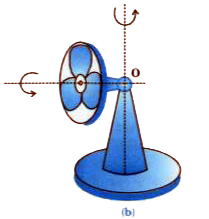Characteristic of rotational motion. Solution in Gujrati
In rotation of a rigid body about a fixed axis, every particle of the body moves in a circle which lies in a plane perpendicular to the axis and has its centre on the axis.

In figure, rotational motion of a rigid body shows about the Z-axis of the frame of reference.
Let P1 be a particle of the rigid body, arbitrarily chosen and at a distance r1 from the fixe axis.
The particle P1 describe a circle of radius r1 with its centre C1 on the fixed axis. The circle lies in a plane perpendicular to the axis.
An another particle P2 of the rigid body, P2 is at a distance r2 from the fixed axis. The particle P2 moves in a circle of radius r2 and with centre C2 on the axis.
The circles described by P1andP2 may lie in different planes, both these planes are perpendicular to the fixed axis.
For any particle on the axis like P3,r3=0. Any such particle remains stationary while the body rotates.

In rotation of a spinning top, the axis may not be fixed as shown in figure. Assume that spinning top rotates at a fixed place.
The axis of such a spinning top moves around the vertical through its point of contact with the ground, sweeping out a cone as shown in figure.
This movement of the axis of the top around the vertical is termed as precession. Here, the point of contact of the top with ground is fixed.
The axis of rotation of the top at any instant passes through the point of contact.
Another example of this kind of rotation is the oscillating table fan or a pedestal fan.

The axis of rotation of such a fan has an oscillating (sidewise) movement in a horizontal plane about the vertical through the point at which the axis is pivoted (point O in figure).
While the fan rotates and its axis moves sidewise, this point is fixed.
Hence is case of a top or a pedestal fan, one point and not one line of the rigid body is fixed.
In this case, the axis is not fixed though it always passes through the fixed point.
Topper's Solved these Questions
- SYSTEMS OF PARTICLES AND ROTATIONAL MOTIONBOOK - KUMAR PRAKASHANCHAPTER - SYSTEMS OF PARTICLES AND ROTATIONAL MOTIONEXERCISE - SECTION-A HOTS
3 Videos
- SYSTEMS OF PARTICLES AND ROTATIONAL MOTIONBOOK - KUMAR PRAKASHANCHAPTER - SYSTEMS OF PARTICLES AND ROTATIONAL MOTIONEXERCISE - SECTION-A (TRY YOURSELF (VSQs))
94 Videos
- QUESTIONS ASKED IN JEE - 2020 BOOK - KUMAR PRAKASHANCHAPTER - QUESTIONS ASKED IN JEE - 2020 EXERCISE - Question
16 Videos
- THERMAL PROPERTIES OF MATTERBOOK - KUMAR PRAKASHANCHAPTER - THERMAL PROPERTIES OF MATTEREXERCISE - Question Paper (Section - D) (Answer following in brief :) Each carry 4 marks
1 Videos
Similar Questions
What is torque? Explain the torque acting on a particle.
View SolutionWhat is a rigid body ? Explain the differences between rigid body and solid body.
View SolutionA non-isotropic solid metal cube has coefficient of linear expansion as 5×10−5/∘C along the x-axis and 5×10−6/∘C along y-axis and z-axis. If the coefficient of volumetric expansion of the solid is n×10−6/∘C then the value of n is....
View SolutionIn an experiment on the specific heat of a metal, a 0.20 kg block of the metal at 150∘C is dropped in a copper calorimeter (of water equivalent 0.025 kg) containing 150 cm3 of water at 27∘C. The final temperature is 40∘C. Compute the specific heat of the metal. If heat losses to the surroundings are not negligible, is your answer greater or smaller than the actual value for specific heat of the metal ?
View SolutionWhat are the characteristics of uniform motion ?
View Solutionक्या कोई वस्तु शुद्ध स्थानांतरीय गति के साथ शुद्ध घूर्णन गति भी कर सकती है ?
View SolutionRotational Motion - Instantaneous Axis Of Rotation
View SolutionRotational power in rotational motion is -
View SolutionRotational Motion | Learn Energy Conservation In Rotational Motion
View SolutionRotational Motion | Instantaneous Axis Of Rotation
View SolutionA couple produces: a) purely translational motion b) purely rotational motion c) both translational and rotational motion d) no motion
View SolutionCOME For Rotational Motion|Rolling Motion
View SolutionThe mixed motion of translational and rotational is a _____ motion.
View SolutionDefine a wave motion, what are characteristics of wave motion?
View Solutionतरंग गति की विशेषताएँ लिखें।
View Solution
